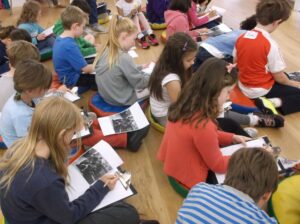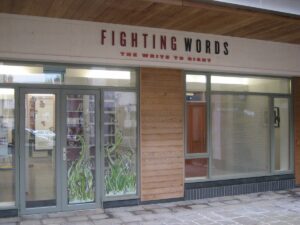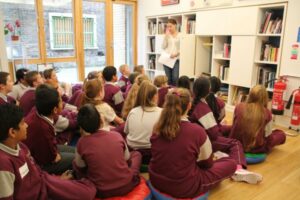
Every Monday morning I hear a group of six to nine-year-olds yelling something like this to the lazy security guard across the street. It’s their own concoction of words that create a personal password to open the magical door that grants them access to a wonderland where they write their very own published stories. It sounds like every child’s fantasy, something that kids can dream about while boring themselves to death in math class or spelling, but it comes to life at Dublin’s very own Fighting Words.
Fighting Words is a nonprofit organization that brings school groups in to write their very own personal stories. Here the students gather together, and develop a story as a group, and then create their own endings and illustrations on their own. It sounds cliche, but it’s as magical an experience for the volunteers as it is for the students.
This isn’t one of those things that I do because it looks good on a resume. Sure, it started as that, but what it morphed into, is this insanely beautiful experience where I get to immerse myself in the culture of Dublin, see the key differences between the youth of America and Ireland, and observe in amazement at how talented children really are, as long as you know how to pull those ideas out of them. Sometimes it’s like pulling teeth to get the children to realize their potential, to show them that there is more to creativity than what they saw online that morning, but the experience is something that is unrivaled by anything else.

In a quiet nook of Northern Dublin, the majestic Fighting Words center lives. The program is beautifully organized, starting with kids gathering in the meeting area to get name tags and get their “about the author” pictures taken. They are then greeted by the volunteer who is in charge of the “magic door” for the day. This person is responsible for helping the kids come up with a password that will turn the magic door around (it’s a bookshelf that rotates, the kids are always trying to debunk it but we try our best). Once they develop the password, which is three original words that the students pick, like “Purple, Ice Cream, Donuts,” they have to gather at the window (so they don’t see said volunteer unhinge the rotating bookshelf) and yell to the “security guard” across the street to open the door. 90% of the time the kids are absolutely amazed. They then take their seats in the beautiful writing center, which is filled with bookshelves overflowing with literature and an art studio where the kids can draw. There they are greeted by their storyteller for the day. As if the kids didn’t have enough motivation to take home their own book as it is, they are introduced to the evil editor Mr. Mahonkey.
Mr. Monhonkey never speaks to the kids, because he thinks they are just a bunch of “babies” that can’t write stories. He speaks to them from behind a wall, and tells them that he doesn’t think that they can do it, tells them that they smell bad and that he would NEVER publish a story written by a bunch of secondary schoolers. Negative reinforcement at its finest. The kids roar with outrage that anyone could ever have the audacity to tell them that they can’t do something. It always sparks something in them, a divine interest in proving the grown-ups wrong. After that, it’s up to the storyteller to guide them through the creative process. Sorting through the children who are starving for attention, pulling muscles in their arms because they raise their hands with such ferocity with sparking ideas, and the quiet kids who are too embarrassed to share their ideas. There’s the art of getting the shy kids to share, yet when they do, they always seem to dazzle the class with their unique and quiet ideas. In the corner, a volunteer illustrated puts their words into stunning pictures, making the kids see their creations come to life.

The idea that these kids come up with are absolutely stunning. It takes a good thirty minutes to steer them away from writing about their favorite Pokemon or YouTube stars (seriously, what is with the youth today and wanting to be youtube stars?) but after that painful time, they dust off the cobwebs of the original parts of their brains and come up with things that adults wouldn’t be able to dream of. The other day, as a group, we wrote a story about Jack the three-legged ghost cow. Jack had a best friend who was a Pig with a ghost tail, and together they were teaming up to build a robotic leg for Jack so that he could be a four-legged ghost cow. Ironically, Jack, the Ghosts cow’s biggest fear was flying, and he’s a ghost! It’s a brilliant idea, with conflict, dialogue, intriguing characters and it’s their very own. As volunteers we act as guides, helping them cross their t’s and dot their i’s. After an hour of contracting the first half of the story, we split up into small groups of two or three, and we help them either finish the story, illustrate the story on their own, or write their own ideas down. It doesn’t matter what they do, as long as they are creative, and now that we have spent an hour exercising those creative muscles, they are aching to make something of their own.
It’s an insanely rewarding experience, watching these kids come in with a sense of wonder, and leaving with the confidence and awe that they just created something. Their VERY OWN book.
Throughout the process there are questions of “will we see Mr. Makonkey,” “do you think he will publish our book,” “Mr. Makonkey seems like the worst,” and the occasional, “why do you have a funny American accent.” They are in a complete state of excitement and wonder as we chug along through the two-hour process, but as we go along you see the confidence building in their own original ideas and thoughts. The sheer pleasure of proving an editor wrong. It breaks them out of their shell and makes them realize their potential. Gone are the cliches of YouTubers, and Pokemon, what is left is a brilliant three-legged ghost cow on his way to getting a new leg.
